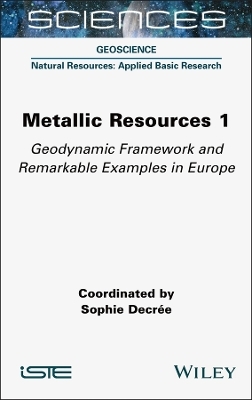
Metallic Resources 1
Iste Ltd (Verlag)
978-1-78945-135-1 (ISBN)
Metallic Resources 1 presents various studies in notable European metallogenic regions or deposits that enable us to tackle the question of the concentration of metals, especially strategic metals, in various geodynamic settings. An understanding of the geological processes that lead to the formation of deposits and influence their concentrations in the Earth's crust is of the utmost importance when it comes to uncovering new mineral resources.
This book puts forward various different methodological approaches necessary in the study of deposits of metallic resources, from field observations to microanalysis. A study of specific geo-politico-economic frameworks is also presented.
Sophie Decrée is a geologist at the Geological Survey of Belgium (Royal Belgian Institute of Natural Sciences). As a specialist in metallogeny, her research has for many years focused on critical raw materials, primarily in Europe and Africa.
Chapter 1 The Rare Earth Resources of Europe and Greenland: Mining Potential and Challenges 1
Nicolas CHARLES, Johann TUDURI, Gaétan LEFEBVRE, Olivier POURRET, Fabrice GAILLARD and Kathryn GOODENOUGH
1.1 Introduction 1
1.2 The extreme diversity of rare earths 3
1.2.1 Rare earth elements 3
1.2.2 Rare earth minerals 6
1.3 The economy of rare earths in the world and their place in Europe 9
1.3.1 The application domains for rare earths 9
1.3.2 The evolution of prices 11
1.3.3 Europe in the rare earth economy 14
1.4 Classification of rare earth deposits 16
1.4.1 Primary endogenous deposits 17
1.4.2 Secondary exogenous deposits 19
1.5 Rare earths deposits in Europe 20
1.5.1 Rare earth indices in the Baltic shield 22
1.5.2 The rare earths indices of the Caledonides 52
1.5.3 Rare earth occurrences in the Variscan belt 56
1.5.4 Rare earths indices from the Mesozoic 64
1.5.5 Rare earth occurrences from the Cenozoic and Quaternary 68
1.6 The rare earths deposits of Greenland 78
1.6.1 The alkaline provinces of the Archean (2,750–2,700 Ma) 79
1.6.2 Paleoproterozoic deposits at Karrat (NIAQ and UMIA) 80
1.6.3 Pegmatites from the late Paleoproterozoic (1,800–1,785 Ma) 82
1.6.4 Gardar Mesoproterozoic alkaline province 82
1.6.5 Carbonatites from the Neoproterozoic to the Mesozoic (southwestern Greenland) 88
1.6.6 Milne Land Jurassic—Cretaceous REE-Ti-Zr paleoplacer 91
1.6.7 Alkaline complexes from the Paleogene (central and eastern Greenland) 92
1.7 The origin of the rare earth deposits in Europe and Greenland 94
1.7.1 Partial melting and crystal fractionation 94
1.7.2 Chlorinity of hydrothermal systems 96
1.7.3 Exogenous rare earth cycle 97
1.8 Strengths and weaknesses of rare earths deposits in Europe and Greenland 100
1.9 Conclusion 106
1.10 Acknowledgments 106
1.11 References 107
Chapter 2 The Cornubian Batholith: Post-Collisional Variscan Granites and Resources 143
Robin SHAIL and Beth SIMONS
2.1 Introduction 143
2.2 Tectonic context of magmatism and resources 146
2.2.1 Variscan tectonics 146
2.2.2 Post-Variscan tectonics 147
2.3 Lamprophyres and basalts 148
2.4 The Cornubian Batholith and associated felsic igneous rocks 150
2.4.1 Geophysical data 150
2.4.2 Field occurrence 151
2.4.3 Mineralogical and textural variation 160
2.4.4 Mineral chemistry 165
2.4.5 Whole-rock geochemistry 166
2.4.6 Geochronology 167
2.4.7 Synthesis 168
2.5 Granite-related mineralization 173
2.5.1 Disseminated magmatic mineralization 175
2.5.2 Pegmatites 176
2.5.3 Replacement deposits 176
2.5.4 Mineralization associated with greisen and potassic alteration 179
2.5.5 Tourmaline-dominated veins, lodes and intrusive breccias 181
2.5.6 Polymetallic sulfide lodes 184
2.5.7 Mineralization models 185
2.6 Post-granite mineralization 191
2.6.1 Cross-course mineralization 191
2.6.2 Five-element (Co-Ni-Bi-As-Ag) and uranium mineralization 193
2.6.3 Hydrocarbons 193
2.7 China clay 193
2.8 The past, present and future of the resources sector in SW England 195
2.8.1 W, Sn, Cu 195
2.8.2 Lithium micas (St Austell granite) 199
2.8.3 Deep geothermal energy 200
2.8.4 Lithium brines 201
2.8.5 Industrial minerals, aggregates and building stones 202
2.9 Environmental, cultural and social impact of mining 203
2.10 References 204
Chapter 3 The W Deposit at Panasqueira (Portugal): A Critical Bibliographical Review 221
Christian MARIGNAC and Michel CATHELINEAU
3.1 Introduction 221
3.2 Geological context 223
3.2.1 Regional context 223
3.2.2 Local geological setting 225
3.2.3 Mineralized vein system 227
3.2.4 The RMG granitic suite at Panasqueira 234
3.3 Relative chronology of the alteration and mineralization stages 237
3.3.1 Historical overview and methodological considerations 237
3.3.2 The paragenetic succession at Panasqueira 240
3.3.3 Wallrock alterations 266
3.3.4 Consequences and implications of revising the paragenesis 267
3.3.5 Absolute chronology 269
3.4 The opening of the veins 271
3.4.1 The opening conditions 271
3.4.2 The origin of the flat joints 272
3.4.3 The place of flat joints in the regional history 276
3.5 P and T conditions at the early and late stages 278
3.5.1 The early stages (stages I–III) 278
3.5.2 Late stages (stages IV–V) 282
3.6 Characterization of the origin of fluids 284
3.6.1 Geochemical arguments: the early stages (I to III-A) 285
3.6.2 Geochemical arguments: the late stages (III-B, IV, V) 287
3.6.3 Mass balances and the source of the fluids 294
3.6.4 Presence of a magmatic component 295
3.7 Role of the Panasqueira granites 295
3.8 Panasqueira: a magmatic and hydrothermal system of crustal scale 298
3.9 References 302
Appendix 1 The Rare Earth Resources of Europe and Greenland: Mining Potential and Challenges 313
Nicolas CHARLES, Johann TUDURI, Gaétan LEFEBVRE, Olivier POURRET, Fabrice GAILLARD and Kathryn GOODENOUGH
Appendix 2 The Cornubian Batholith: Post-Collisional Variscan Granites and Resources 325
Robin SHAIL and Beth SIMONS
Appendix 3 The Panasqueira W Deposit (Portugal): A Critical Bibliographic Review 329
Christian MARIGNAC and Michel CATHELINEAU
List of Authors 353
Index 355
Summary of Volume 2 363
| Erscheinungsdatum | 18.01.2024 |
|---|---|
| Verlagsort | London |
| Sprache | englisch |
| Gewicht | 789 g |
| Themenwelt | Naturwissenschaften ► Geowissenschaften ► Geologie |
| ISBN-10 | 1-78945-135-3 / 1789451353 |
| ISBN-13 | 978-1-78945-135-1 / 9781789451351 |
| Zustand | Neuware |
| Haben Sie eine Frage zum Produkt? |
aus dem Bereich


